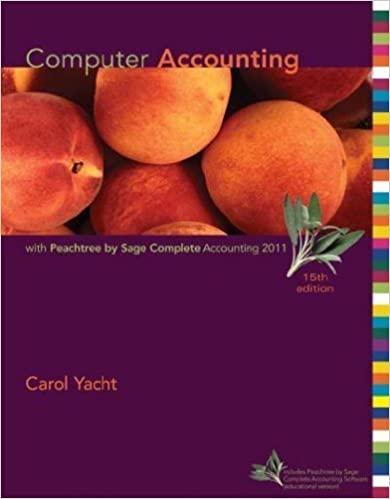Question
Revenue Journal; Accounts Receivable subsidiary and General Ledgers Sage Learning Centers was established on July 20 to provide educational services. The services provided during the
Revenue Journal; Accounts Receivable subsidiary and General Ledgers
Sage Learning Centers was established on July 20 to provide educational services. The services provided during the remainder of the month are as follows:
| July 21. | Issued Invoice No. 1 to J. Dunlop for $115 on account. |
| July 22. | Issued Invoice No. 2 to K. Tisdale for $350 on account. |
| July 24. | Issued Invoice No. 3 to T. Quinn for $85 on account. |
| July 25. | Provided educational services, $300, to K. Tisdale in exchange for educational supplies. |
| July 27. | Issued Invoice No. 4 to F. Mintz for $225 on account. |
| July 30. | Issued Invoice No. 5 to D. Chase for $170 on account. |
| July 30. | Issued Invoice No. 6 to K. Tisdale for $120 on account. |
| July 31. | Issued Invoice No. 7 to T. Quinn for $105 on account. |
Required:
1a. Journalize the transactions (in chronological order as it appears in the data) for July, using a single-column revenue journal


1c. Post to the following customer accounts in the accounts receivable ledger, and insert the balance immediately after recording each entry: D. Chase; J. Dunlop; F. Mintz; T. Quinn; K. Tisdale.
If an amount box does not require an entry, leave it blank. In CNOW, Journal pages begin with J and Revenue Journal begin with R. For example Journal/ Revenue Journal, page 1/1 respectively. POST. REF. is simply J1 and R1.

2. Post the revenue journal and the general journal to the following accounts in the general ledger, inserting the account balances only after the last postings:
| 12 | Accounts Receivable |
| 13 | Supplies |
| 41 | Fees Earned |
If an amount box does not require an entry, leave it blank. In CNOW, Journal pages begin with J and Revenue Journal begin with R. For example Journal/ Revenue Journal, page 1/1 respectively. POST. REF. is simply J1 and R1.

4. Assume Sage Learning Centers began using a computerized accounting system to record the sales transactions on August 1. All of the following are benefits of the computerized system over the manual system EXCEPT:
A.) Totals in the subsidiary ledgers would be calculated automatically.
B.) There would be no need to verify the accuracy of account totals.
C.) There would be no need to enter sales transactions into an electronic form.
D.) There would not be math or posting errors.
1a. Journalize the transactions in chronological order as it appears in the data) for July, using a single-column revenue journal. REVENUE JOURNAL PAGE 1 Accts. Rec. Dr. Fees Earned Cr. Date Invoice No. Account Debited Post. Ref. 1b. Journalize (including the date) and post the appropriate transaction for July in the two-column general journal. If an amount box does not require an entry, leave it blank. Posting references will be recorded in part 2. 1b. Journalize (including the date) and post the appropriate transaction for July in the two-column general journal. If an amount box does not require an entry, leave it blank. Posting references will be recorded in part 2. JOURNAL PAGE 1 Date Description Post. Ref. Debit Credit E ACCOUNTS RECEIVABLE SUBSIDIARY LEDGER Date Item Post. Ref. Dr. Cr. Balance Name: D. Chase Name: J. Dunlop Name: F. Mintz Name: T. Quinn Name: K. Tisdale GENERAL LEDGER Balance Date Item Post. Ref. Dr. Cr. Dr. Cr. Account: Accounts Receivable #12 Account: Supplies #13 Account: Fees Earned #41 3a. What is the sum of the balances of the customer accounts in the subsidiary ledger at July 31? 0 0 3b. What is the balance of the accounts receivable controlling account at July 31Step by Step Solution
There are 3 Steps involved in it
Step: 1

Get Instant Access to Expert-Tailored Solutions
See step-by-step solutions with expert insights and AI powered tools for academic success
Step: 2

Step: 3

Ace Your Homework with AI
Get the answers you need in no time with our AI-driven, step-by-step assistance
Get Started


